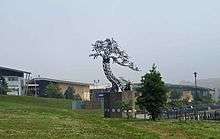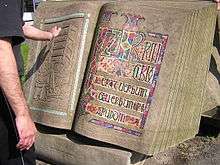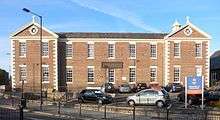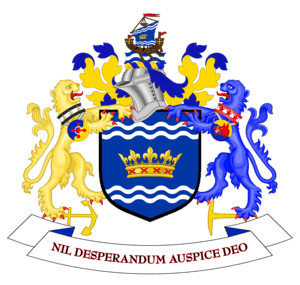University of Sunderland
 | |
Former names | Sunderland Technical College (1901-1969), Sunderland Polytechnic (1969-1992) |
|---|---|
| Motto | Scientiam Dulce Hauriens |
Motto in English | Sweetly absorbing knowledge |
| Type | Public |
| Established |
1992 - University of Sunderland (gained University status) 1969 - Sunderland Polytechnic 1901 - Sunderland Technical College |
| Chancellor | Steve Cram[1] |
| Vice-Chancellor | Shirley Atkinson |
| Students | 13,695 (2014/15)[2] |
| Undergraduates | 10,895 (2014/15)[2] |
| Postgraduates | 2,800 (2014/15)[2] |
| Location | Sunderland, Tyne and Wear, United Kingdom |
| Campus | Three campuses |
| Colours | Nasturtium & Dark Blue [3] |
| Affiliations | Coalition of Modern Universities, Million+ |
| Website |
www |
The University of Sunderland is a university located in Sunderland in the North East of England. The university has 13,695 students and was one of six universities to be short-listed for 'University of the Year' in the Times Higher Education Supplement Awards 2012.[4]
History
Sunderland has been an important centre for education since 674 AD, when Benedict Biscop built St. Peter's Church and monastery. St. Peter's Church was the site of the greatest scriptorium north of the Alps. The oldest existing Latin version of the Bible – the Codex Amiatinus – was written at St Peter's Church. This area has been developed as the Sir Tom Cowie Campus at St Peter's of the University of Sunderland. The University's £9m state-of-the-art Media Centre, launched in 2004, is near St. Peter's Church.
Sunderland Technical College

The university's modern roots can be traced back to 1901, when Sunderland Technical College was established as a municipal training college. It was the first to offer sandwich courses. Pharmacy and naval architecture departments were established in 1921 and 1922 respectively. The Pharmacy Department began as a single bench in the Chemistry Department, but soon grew to become the largest in the country. From 1930, some students in the Faculty of Applied Science read for degrees of the University of Durham. In 1930, a Mining Department was established and pharmacy students could read for the Bachelor of Pharmacy degree of the University of London.[5] Sunderland was also recognised by London University as a centre for its BEng (Bachelor of Engineering) degree in 1934.
During the Second World War, Sunderland ran special courses for the armed forces and the Ministry of Labour.
In the 1960s, a PDP-8 hybrid computer was installed at the Chester Road site.
A new complex of buildings, including a new Students' Union and Hall of Residence facilities, on nearby Chester Road was opened by the Duke of Edinburgh in 1964.
Sunderland Polytechnic
Sunderland Polytechnic was established on 26 January 1969, incorporating the Technical College, the School of Art (which was also established in 1901) and the Sunderland Teacher Training College (established in 1908). Sunderland was among the first of 30 Polytechnics, like polytechnics or technological universities in other countries their aim was to teach both purely academic and professional vocational subjects. Their focus was applied education for work and their roots concentrated on engineering and applied science, they also created departments concerned with the humanities. It is considered one of the best universities in the North East of England.
As a polytechnic, Sunderland created the first part-time, in-service BEd (Bachelor of Education) programme in the country.
University status
After the passage of the Further and Higher Education Act 1992, the polytechnic gained university status.[6]
The university was recognised by The Guardian as England's best new university in 2001. In 2005 it was named by The Times Higher Education Supplement as the top university in England for providing the best student experience.
Lord Puttnam became the university's first Chancellor in 1998. The Sunderland Empire Theatre was the regular venue for the graduation ceremonies, although they have been hosted at the Stadium of Light since 2004. In July 2007, he stepped down to become the Chancellor of the Open University.[7][8]
On 23 May 2008 the University announced that former Olympic athlete Steve Cram had been appointed as Chancellor and would be officially installed at a ceremony on 27 June 2008.[1]
Campuses



There are two campuses in Sunderland, and one in London. The Sunderland campuses are City Campus and the Sir Tom Cowie Campus at St Peter's. St Peter's opened during the 1990s on the north bank of the River Wear, the site of St. Peter's Church and monastery built by Benedict Biscop in 674AD.
In September 2002, the campus was renamed "The Sir Tom Cowie Campus at St. Peter's", after the local businessman who was one of the university's primary supporters. The Sunderland Business School is similarly named "The Reg Vardy Centre", and another building, primarily used by the School of Computing and Technology, is "The David Goldman Informatics Centre".
St Peter's Campus includes the following: North Shore (formerly Campus and Manor Quay), Wearbank House, Reg Vardy Centre, St Peter's Library, David Goldman Informatics Centre, Prospect Building (including Sir Tom Cowie Lecture Theatre), David Puttnam Media Centre, North Sands Business Centre and National Glass Centre (which houses the Glass and Ceramics department and the Institute for International Research in Glass). The David Puttnam Media Centre houses television and radio production facilities for the School of Arts, Design and Media and student radio station (107 Spark FM), and Spark TV, and opened in 2003. The campus was officially opened in March 2004 by Estelle Morris, former Education Secretary and Pro Vice-Chancellor from 2005-2009.
In 2006, the Chester Road Campus was renamed City Campus, and work started on refurbishment of the Edinburgh Building administrative centre, the creation of the Gateway one-stop-shop for student support, and the redevelopment of Murray Library, and the Design Centre. The £12M CitySpace gym and leisure development opened in 2009, and in February 2011 the £8.5M Sciences Complex opened.[9]
London Campus
On 26 April 2012, the University of Sunderland announced the opening of a new campus at Canary Wharf in London,.[10][11] In 2012/13 the student population of the University of Sunderland London Campus was 2,277.
Courses are offered in nursing, business, tourism and hospitality, as well as accounting and financial management.
Design Centre
This vibrant community of designers, housed on the City Campus, has 370 masters and undergraduate students studying Animation, Advertising, Graphic Communication, Illustration and Fashion Product and Promotion. A substantial community of design research active staff with interests in science communication, contemporary calligraphy, data visualisation and computational design have national and international recognition. A recent graduate from Animation and Design won his second BAFTA for his film for CITV.
Halls of residence
The University of Sunderland has five halls of residence: Scotia Quay, Panns Bank, Clanny House, The Precinct and The Forge U-Student Village.[12]
Clanny House is the largest halls of residence and is located on Hylton Road across the road from the Sunderland Royal Hospital.
The Precinct is located on Chester Road and is a short walk from the City Campus.
Scotia Quay and Panns Bank are based across the River Wear from St Peter's Campus, across the road from The Bonded Warehouse. The location of these halls used to be one of the many locations on the river that were used by the former ship building industry.
Previous halls of residence include Ashbrooke, All Saints, Clifton, Westfield, Park and Williamson Halls.
Organisation

The University has four academic faculties, responsible for teaching and learning, academic development and research, and working with partners in business and industry.
The Faculties are supported by a number of service departments responsible for a wide range of activity such as student welfare and accommodation and includes teams with responsibility for managing the University estate, financial matters, and human resources.
- Arts, Design, Media: Creative and Performing Arts, Design, Dance, Drama, Music, Journalism, PR, Film, Media, Cultural Studies, Fine Art, Glass, Ceramics, Photography, Radio, TV, Video, New Media
- Business & Law: Accounting, Business, Management, Law, Tourism
- Education and Society : Education, English, Health Studies, History, Social Sciences, Combined Subjects
- Applied Science: Computing, Engineering, Psychology, Nursing, Environment, Pharmacy, Clinical Sciences, Sport and Exercise Sciences
The North East England Mining Archive and Resource Centre (NEEMARC) is a major archive for mining related data and includes health and safety information, legal records, technical reports and trade union records. NEEMARC is situated within the Special Collections Room of the Murray Library.[13][14]
Rankings and reputation
According to The Complete University Guide League Tables 2016, the University of Sunderland was ranked 103rd out of 127, an improvement on the previous year in which the university was ranked 116th.[15]
Research
"The University of Sunderland is a research active university, with a research active curriculum, enhancing the academic standing of the institution as a seat of higher learning and scholarship, undertaking research which both enhances the learning experience of our students, and delivers impact"
Our research is stitched into the fabric of the institution. For decades researchers at the University have challenged themselves to improve society across all its facets – from the early days of pharmacy to support for heavy industry at its height to today’s new sciences and advanced technologies. Shirley Atkinson, Vice Chancellor & Chief Executive
The University of Sunderland's research was classed as 'world leading' in 10 subjects by the latest Research Excellence Framework (REF 2014). The 10 subjects are: Pharmacy, Engineering, Business, Education, Social Work, Sports and Exercise Sciences, Leisure and Tourism, English, History, Art and Design, and Media as were an additional 3 subject areas: Music, Dance, and Performing Arts classed as 'internationally excellent'.
Student life

The University of Sunderland Students' Union is headed by five sabbatical officers who run the Union and are elected into the roles by their peers for a period of one year. The current officer positions are President, Vice President, Education and Welfare Officer, Sports and Activities Officer and Entertainments and Media Officer. They are augmented by five lay Trustees to make up the Trustee Board.
The Students' Union is responsible for providing events, offering support and advice, fundraising and supporting campaigns and being the 'voice' of the student body.
The Students' Union currently has two bars, one being The Bonded Warehouse, located near the Panns bank and Scotia Quay halls of residence, and North Shore (formerly Manor Quay/Campus) located on the St. Peters campus. Both venues offer cheap food and drinks, and have a variety of theme nights throughout the course of the academic year. North Shore is a brand new 'Student Hub' for the academic year 2010/11 and encases a green centre, bar & grill, theatre and nightclub.
The student union magazine is called DN (Degrees North) magazine and student/community centred radio station Spark FM, part of the wider Spark Media Group, operates from within the Media department but is not exclusively operated as a student concern.
Sport
The University’s Institute of Sport organises training events, courses and other sporting activities for students, staff and the local community.
There are over 45 clubs and societies, with over 2500 members in 2011/12. Users have access to the £12m CitySpace building on the City Campus, which features a climbing wall, fitness suite, physiotherapy and injury centre, sports hall, multi-purpose suite and spectator seating.
SportsByte
Launched in September 2011, SportsByte is a journalism, news, and multimedia publication dedicated to covering a wide range of sports at all levels of competition across the City of Sunderland, the North East, and Globally. With a press team of over 150 student and community reporters, SportsByte is the largest sports-dedicated news and media publication in the North East of England, and is among the biggest in the UK. Within six months the website had spread its coverage to over thirty different sports and activities, and published three digital magazines. In spring 2012 SportsByte gained national praise, making the final shortlist for the National Union of Students National Student Journalism Awards 'Best Student Media' award.
The University of Sunderland’s Institute of Sport launched SportsByte in 2011 after months of planning and development with the Faculty of Art, Design, and Media’s lead academic Journalism staff. From their work at the forefront of Sport in Sunderland, the Institute were passionate about improving the knowledge and awareness of teams, clubs, programmes, and issues that are typically crowded out by other news stories and features in local and regional press. The two primary objectives of providing first rate journalism and coverage for sport within the area, as well as real-life and professional experience for students studying Journalism, are a perfect match.
107 Spark FM
Spark FM is a community radio station, The station was awarded a full Community Radio licence in 2008 from Ofcom. The station launched in October 2009 and broadcasts 24/7 from its base, The David Puttnam Media Centre, located at the St. Peter's University campus. It has a long heritage, through student programming on Wear FM and then temporary licences under the Utopia FM name between 1997 and 2008. The station is operated by a team of student and community volunteers.
Spark FM has been successful in regional, national and international radio awards. The station itself has now won 3 awards as Best Student Radio Station in the New York Radio Awards where students have also gained awards for Radio Drama, Radio Documentary and Entertainment. Former volunteers are now working for BBC Radio 1, Capital FM and other BBC and Commercial Broadcasters.
Notable alumni
- J. Alan Biggins TD MA MSc PhD FSA - Scientist and Surveyor; MIBiol 1977
- Richard Billingham - English photographer and artist who is best known for his photobook Ray's A Laugh which documents the life of his alcoholic father Ray, and obese, heavily tattooed mother, Liz.[16]
- Kerry Ann Christiansen - British actress who began her career in the popular British children’s TV series Byker Grove.[17]
- Steve Cram - Retired track and field athlete. Along with fellow Britons Sebastian Coe and Steve Ovett, he was one of the world's dominant middle distance runners during the 1980s.[18]
- Terry Deary - British children's author of over 200 books, selling over 25 million copies in over 40 languages.[19]
- Ortis Deley - English television presenter, radio DJ and actor.[20]
- Carl Ivar Hagen - Norwegian politician and former Vice President of the Norwegian Parliament.[21]
- Goldie Harvey - Nigerian professional singer and a Big Brother Africa star.[22]
- Mike Johnson - Chief Executive Officer of multinational company Castrol Oil where during his tenure he worked in Latin America, Asia and Europe.[23]
- Jaz Martin - English film, television and stage actor.[24]
- Peter McArdle - English artist, member of the Stuckists art group and gallery owner.[25]
- Katy McLean - Rugby player, captain of England Women's National Rugby Union team.[26]
- Jonathan Morrell - English presenter and journalist currently employed by Channel 7, in Perth.[27]
- Andy Ogle - professional Mixed Martial Artist, Former Featherweight for UFC.[28]
- Ross Pearson - Professional Mixed Martial Artist, Lightweight for the UFC, Lightweight Winner of The Ultimate Fighter: United States vs. United Kingdom
- Mike Rumbles - Former Scottish Liberal Democrat politician.[29]
- Tony Scott - English film director and producer.[30]
- Chris Stevenson - Author and professor of mental health nursing at Dublin City University, where she was also head of the School of Nursing.[31]
- Robin Storey - English ambient musician with Zoviet France and Rapoon.[32]
- Andrew Singleton - British neurogeneticist currently working in the USA.[33]
- Charlie Spedding - English former long-distance runner.[34]
- Andrew Zisserman - Computer Vision Researcher[35]
See also
- Category:Alumni of the University of Sunderland
- Category:Academics of the University of Sunderland
References
- 1 2 "Steve Cram named new Chancellor" (Press release). University of Sunderland. 2008-05-23. Retrieved 2008-06-16.
Steve has a strong relationship with the university, going back 25 years, so he was an obvious choice for Chancellor. In 1983 Cram received his sports studies degree from Sunderland. Three years later the former 1500m world record holder was back at the university to receive an Honorary Fellowship for his outstanding contribution to sport. In 1994 he became Honorary President of the University of Sunderland Alumni Association.
- 1 2 3 "2014/15 Students by HE provider, level, mode and domicile" (XLSX). Higher Education Statistics Agency. Retrieved 19 January 2016.
- ↑ Academic Colours Sunderland University Academic Dress
- ↑ "THE Awards 2012 shortlist". Times Higher Education. Retrieved 20 September 2014.
- ↑ Sunderland Technical College Education Prospectus for 1967–1968
- ↑ "Our History". The University. University of Sunderland. Retrieved 2008-06-16.
- ↑ Hale, Dean (2006-11-02). "Lord Puttnam to step down as Chancellor". AblogUS - University of Sunderland blog. University of Sunderland. Retrieved 2008-06-16.
Lord Puttnam has been appointed to the post of Chancellor at the Open University, and will step down from his role of Chancellor at the University of Sunderland following the July 2007 awards ceremonies. When Lord Puttnam presides over his final degree ceremony in July 2007, it will mark ten years since his appointment as the University of Sunderland's first Chancellor.
- ↑ "Lord Puttnam is appointed Chancellor of The Open University" (Press release). Open University. 2006-10-03. Retrieved 2006-10-08.
Speaking about the appointment, Lord Puttnam said: "Having enjoyed an incredibly fruitful decade as Chancellor of the University of Sunderland, I'm delighted to have been offered the chance to make a similar contribution to the institution that most clearly mirrors my own academic journey."
- ↑ "Sunderland University's new £8.5m science complex opens". BBC News. 16 February 2011.
- ↑ "Canary Wharf campus for Sunderland University". journallive. Retrieved 20 September 2014.
- ↑ http://www.sunderland.ac.uk/londoncampus/ University of Sunderland London Campus
- ↑ "Accommodation". Retrieved 20 September 2014.
- ↑ "The NEEMARC Collection - University Library Services". Retrieved 20 September 2014.
- ↑ "Mining for Family History and NEEMARC University Library Services". Retrieved 20 September 2014.
- ↑ "Complete University League Table" (Press release). The Comlete University Guide. 27 September 2016. Retrieved 27 September 2016.
- ↑ Richard Billingham
- ↑ Kerry Ann Christiansen
- ↑ Steve Cram
- ↑ Terry Deary
- ↑ Ortis Deley
- ↑ Carl I. Hagen
- ↑ Goldie Harvey
- ↑ "Mike Johnson Profile".
- ↑ Jaz Martin
- ↑ Peter McArdle
- ↑ Katy McLean
- ↑ Jonathan Morrell
- ↑ "Andy Ogle UFC Profile". Retrieved 2014. Check date values in:
|access-date=(help) - ↑ Mike Rumbles
- ↑ Tony Scott
- ↑ Chris Stevenson
- ↑ http://www.discogs.com/artist/98232-Robin-Storey
- ↑ Andrew Singleton
- ↑ Charlie Spedding
- ↑ Andrew Zisserman
External links
| Wikimedia Commons has media related to University of Sunderland. |
Coordinates: 54°54′18″N 1°23′29″W / 54.9051°N 1.3914°W
